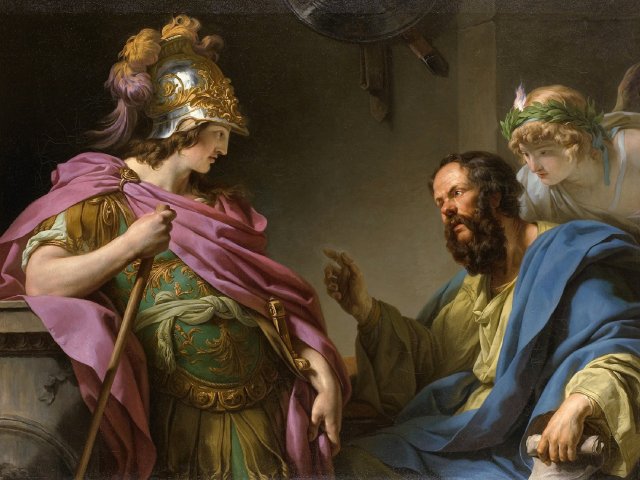"The institution of this Imperial Russian Academy
has been granted to improve and exalt...
our Word...",
from Princess E. R. Dashkova's address to the academicians.
One fine day two intelligent and determined women were strolling through the garden. Their conversation turned to the Russian literature.
"We only need rules and a good dictionary to make our language independent of foreign words and expressions that have neither the energy nor the power typical of our word," suggested the first interlocutor.
"I am wondering myself why that thought has not yet been put into action," said the other one in amazement.
It was a conversation between Princess Yekaterina Romanovna Dashkova and Empress Catherine the Great. As soon as the princess put her thoughts in writing, the Empress signed the decree.
In 1783 following the model of the French Academy, a literary academy for the study of the Russian language and literature – the Russian Academy – was established in St. Petersburg.
Russian is a great and powerful language, yet it was not immediately possible to structure all its richness and create a certain system of rules. For a long time, the noble society preferred French to their native language; there were many borrowings from German and English in their speech. The Academy had to structure the language and strengthen its influence in the first circles:
"The Imperial Russian Academy must have the purification and enrichment of the Russian language, the general establishment of the use of its words, its peculiar eloquence and poetry as its object."
Originally, meetings of academicians were held in the conference hall of the St. Petersburg Academy of Sciences or in the house of Princess Dashkova, until the government allocated 26,000 rubles. This money was used to purchase a building on the banks of the Fontanka River behind the Obukhovsky Bridge and renovate it. Just like Plato's Academy, a botanical garden was laid out near the building. But all this property was confiscated in 1796 after Dashkova, who was actually exiled to the estate near Moscow by Catherine for spreading freethinking ideas and publishing the tragedies "Vadim" by Yakov Knyazhnin and "Life of F. V. Ushakov" by Alexander Radishchev, was repressed by Paul I for taking part in the overthrow of Peter III.
The Academy consisted of 60 members. Meetings were held weekly, with all attendees receiving a silver token as a keepsake. The first results came just a month and a half after the work began: a new letter of the Russian language, Yo (Ё), was proposed.
In 1786–1797 the academicians decided to collect all printed and handwritten theatrical plays. A collection "Russian theater, or Complete collection of all the works of Russian theater" in 43 parts was published.
The most famous work of the Academy was the publication of the "Dictionary of the Russian Academy, derivatively arranged" in six parts in 1789–1794 – the first explanatory dictionary of the Russian language. The Dictionary contained 43,257 words. The words were arranged according to the common root, forming branched semantic nests. The work was completed in 11 years. As a comparison, it took the French Academy 60 years to compile its first dictionary. The second edition, "Dictionary of the Russian Academy, in alphabetical order located" was published in 1806–1822 and included 51,388 words together with new ones that were introduced into science by Mikhail Vasilyevich Lomonosov.
The dictionary was compiled in parts, each academician had their own letters. Dashkova personally collected and explained the words to the letters Ts, Sh, and Sch, as well as words related to hunting, government administration, and words of moral and ethical connotations. The comedy dramatist D. I. Fonvizin explained the words to the letter L; the letter T went to G. R. Derzhavin; the letter U went to Count A. S. Stroganov; and E went to I. I. Shuvalov. All in all, 35 academicians took part in the creation of the Dictionary. The Empress closely followed the work on the dictionary. When the academicians reached the letter N, she impatiently exclaimed, "Still Ours (Nash) and Ours! When will you tell me: Yours (Vash)?". The creators were awarded special gold medals.
The 19th century also saw the development of the Dictionary of the Church Slavonic and Russian language, which was completed and published only in 1847, after the Russian Academy joined the St. Petersburg Academy of Sciences.
In the 1820s the last president of the Academy, A. S. Shishkov, set the task of creating a pan-Slavic dictionary. He decided to create a common library for Slavic peoples in St. Petersburg. The materials were collected in Poland, Serbia, and Czech Republic. In the mid-1830s the academy turned to history. The Byzantine chronicles of Leo the Deacon, Constantine Porphyrogenitus, Procopius, John Cantacuzene, George Sinclair, and Theophanes of Byzantium were translated in search of ancient references to the Slavs.
After the death of A. S. Shishkov, by decree of Nicholas I, the Russian Academy was transformed into the "second" Department of the Russian Language and Literature of the Imperial St. Petersburg Academy of Sciences, which now bacame the Russian Academy of Sciences.
The article is based on open sources.
Фото на странице: Николай Мохначев / «Научная Россия»






















